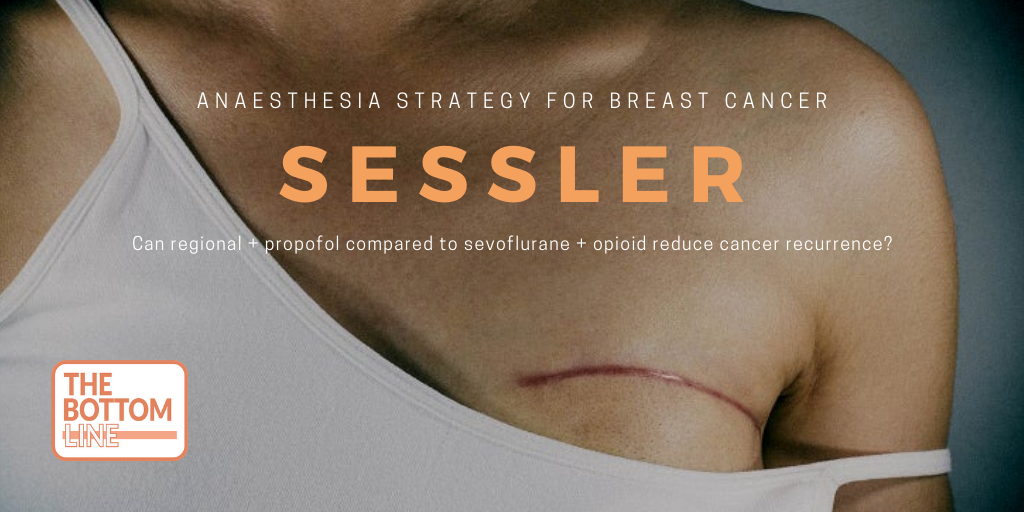Sessler

Recurrence of Breast Cancer after regional or general anaesthesia: A randomised control trial.
Sessler D et al. Lancet 2019 November ; 394:1807-1815. :DOI: 10.1016/S0140-6736(19)32313-X
Clinical Question
- In patients with breast cancer having potentially curative surgery, does a strategy of paravertebral block and propofol anaesthesia, compared to a strategy of opioid and sevoflurane anaesthesia, reduce local or metastatic recurrence?
Background
- Studies have debated the effect of anaesthetic technique on cancer recurrence
- Volatile anaesthesia and opioids have been associated with immunosuppression and increased metastatic tumour cell activity in vitro, while propofol and regional anaesthesia have been shown to reduce those effects
- Breast cancer is the most common cancer in women, causing 11,400 deaths a year
- Previous studies have shown mixed results- some have suggested a reduction in breast cancer recurrences with regional anaesthesia, others have shown no difference
Design
- Randomised, multicentre, single blind study
- 1:1 computerised generated randomisation, stratified by study site with random blocking
- Allocation concealment until shortly before surgery
- Follow up performed by blinded investigator
- Intention-to-treat analysis
- 356 recurrences need to be observed to give 85% power to detect 30% reduction in cancer recurrence
- Interim analysis to be performed at 25%, 50%, and 75% of recruitment
- Expected to complete in 5 years
- Primary outcome method assessed using adjusted Cox proportion hazard model
- Secondary outcomes assessed using Wilcoxon Rank Sum
Setting
- 13 Hospitals across 8 countries
- Argentina, Austria, China, Germany, Ireland, New Zealand, Singapore, USA
- Jan 2007 to Jan 2018
Population
- Inclusion
- Women <85
- Primary breast cancer (tumour stage 1-3, nodes stage 0-2)
- Unilateral or bilateral mastectomy, with or without implants OR
- Wide local excision with node dissection
- Exclusion:
- Previous breast cancer surgery
- Inflammatory breast cancer
- Free flap reconstruction
- ASA IV or higher
- Contraindication to either approach
- Another cancer
- 2134 patients randomised, 2108 patients included in final analysis
- Baseline demographics similar between groups
- 59% recruitment from China
Intervention
- Ultrasound guided paravertebral block at T1-T5
- Multiple injection technique used
- Propofol 60–90mcg/kg/min as maintenance
- Supraglottic airway preferred over ETT
- Conventional general anaesthetic permitted if block failed
Control
- 1–3mcg/kg fentanyl, 2–4mg/kg propofol induction
- ETT or Supraglottic airway
- Sevoflurane in 20% Nitrous and 80% O2 maintenance
- Ventilated to ETCO2 4kPa
- Fentanyl boluses intraoperatively
Management common to both groups
- Midazolam/fenanyl premed
- Opioids as clinically necessary
- Temperature control, haemoglobin targets, depth of anaesthesia monitoring, and management of PONV standardised
- Paracetamol and NSAIDS as post-op analgesia
- IV patient controlled analgesia (PCA) with opiates if needed
- Transition to oral agents over 24 hours
Outcome
- Primary outcome: Recurrence free cancer survival
- Study terminated at 50% analysis – 211 recurrences analysed
- 102/1043 recurrences in regional group (10%) vs 111/1065 recurrences (10%) in GA group
- No significant difference
- No significant difference seen on multiple subgroup analyses
- Secondary outcome:
- Chronic pain at 6 and 12 months: no difference
- Opioid consumption at 48 hours: no difference
- PONV in recovery: 8% vs 20%
- PONV at 48 hours: no difference
Authors’ Conclusions
- Regional anaesthesia-analgesia by paravertebral blocks and propofol did not reduce breast cancer recurrence after potential curative surgery compared with general anaesthesia with the volatile anaesthetic sevoflurane and opioids for analgesia
Strengths
- Important clinical question
- Randomised
- Blinded
- Registered on clinicaltrials.gov
- Intention to treat analysis
- Multi-centre recruitment providing strong external validity
Weaknesses
- Trial terminated early, so technically underpowered
- Surgical technique not standardised
- Slow recruitment (11 years)
- Significant changes in breast cancer treatment during this time may have affected results
- Paravertebral technique not standardised, limiting internal/external validity
- Paravertebral technique used does not reflect what is currently considered best practice (a single targeted injection below the costotransverse ligament, with pleural drop as the end point)
- The sensory level of the blocks were not tested prior to- or post- anaesthesia
- While this may be important for blinding, it does bring into question their low block failure rate of 5/1043
- The majority of the recruits were from China
- While there were no differences seen on subgroup analysis by ethnicity, other factors such as surgical technique or medical follow up may have skewed results
The Bottom Line
- This large RCT of opiate-free anaesthesia with paravertebral block compared to sevoflurane and opioid based anaesthesia did not show any differences in breast cancer recurrence rates
- It was underpowered, slow to recruit, and did not standardise the regional technique used, and therefore is not a conclusive trial comparable to my local practice
-
The role of anaesthetic technique in cancer care remains uncertain
External Links
- [article] Recurrence of Breast Cancer after regional or general anaesthesia: A randomised control trial
- [Editorial] Anaesthetic interventions and long term tumour recurrence
- [Letter] Can anaesthetic-analgesic technique during cancer surgery of curative intent influence recurrence of metastasis? An update.
Metadata
Summary author: Segun Olusanya
Summary date: 23 Nov 2019
Peer-review editor: Duncan Chambler



